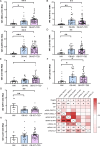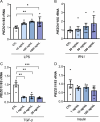Increased expression levels of PIEZO1 in visceral adipose tissue in obesity and type 2 diabetes are triggered by mechanical forces and are associated with inflammation
- PMID: 39707172
- PMCID: PMC11660983
- DOI: 10.1186/s10020-024-01008-1
Increased expression levels of PIEZO1 in visceral adipose tissue in obesity and type 2 diabetes are triggered by mechanical forces and are associated with inflammation
Abstract
Background: PIEZO1 has emerged as a mechanoreceptor linked with adipogenesis, adipose tissue (AT) inflammation and insulin resistance. We aimed to determine the impact of obesity and obesity-associated type 2 diabetes (T2D) as well as mechanical compression forces on the expression of PIEZO1 in visceral AT (VAT) and its relation with inflammation.
Methods: Blood and VAT samples were obtained from 100 volunteers. Static compression studies in VAT explants were performed to study the PIEZO1 response. The effect of bariatric surgery on the expression of Piezo1 was assessed in a rat model of diet-induced obesity.
Results: Obesity and obesity-associated T2D increased (P < 0.01) gene expression levels of PIEZO1 in VAT mainly due to adipocytes. SWELL1 and key markers of inflammation (NLRP3, NLRP6, IL1B, IL18 and IL8) were also upregulated in VAT in obesity and T2D being significantly associated (P < 0.01) with PIEZO1 levels. We further showed that the static compression of VAT explants promoted an upregulation of PIEZO1 (P < 0.01) and SWELL1 (P < 0.01) expression levels together with a strong increase in the expression and release of key inflammatory mediators. The treatment of THP-1-derived macrophages with the secretome of adipocytes from patients with obesity upregulated (P < 0.001) PIEZO1 levels. Rats undergoing bariatric surgery exhibited decreased (P < 0.01) expression levels of Piezo1 in the epididymal AT.
Conclusions: Static compression triggered an upregulation of PIEZO1 in VAT explants together with a strong inflammation. In addition, the increased expression of PIEZO1 in VAT in obesity and obesity-associated T2D, primarily attributable to adipocytes, is closely associated with SWELL1 and inflammatory markers.
Keywords: Inflammation; Mechanotransduction; Obesity; PIEZO1; Type 2 diabetes; VAT.
© 2024. The Author(s).
Conflict of interest statement
Declarations. Ethics approval and consent to participate: The protocol of the research was conformed to the guidelines of the Declaration of Helsinki and was approved by the Universidad de Navarra’s Ethical Committee (protocol 2020.054). The animal procedures followed the European Guidelines for the Care and Use of Laboratory Animals (directive 2010/63/EU) and were approved by the Ethical Committee for Animal Experimentation of the University of Navarra (2019.089). Informed consent was obtained from all individual participants included in the study. Consent of publication: Not applicable. Competing interests: The authors declare no competing interests.
Figures







References
-
- Alkhouli N, Mansfield J, Green E, Bell J, Knight B, Liversedge N, et al. The mechanical properties of human adipose tissues and their relationships to the structure and composition of the extracellular matrix. Am J Physiol Endocrinol Metab. 2013;305:E1427-1435. - PubMed
-
- Baxter EW, Graham AE, Re NA, Carr IM, Robinson JI, Mackie SL, et al. Standardized protocols for differentiation of THP-1 cells to macrophages with distinct M(IFNg+LPS), M(IL-4) and M(IL-10) phenotypes. J Immunol Methods. 2020;478: 112721. - PubMed
-
- Becerril S, Cienfuegos JA, Rodriguez A, Catalan V, Ramirez B, Valenti V, et al. Single anastomosis duodeno-ileal bypass with sleeve gastrectomy generates sustained improvement of glycemic control compared with sleeve gastrectomy in the diet-induced obese rat model. J Physiol Biochem. 2024;80:149–60. - PMC - PubMed
MeSH terms
Substances
Grants and funding
LinkOut - more resources
Full Text Sources
Medical
Miscellaneous

